Morphological and Gamma-Ray Attenuation Properties of High-Density Polyethylene Containing Bismuth Oxide
Abstract
:1. Introduction
2. Materials and Methods
2.1. Sample Preparation
2.2. Morphological Test
2.3. Gamma Attenuation Test
3. Results and Discussion
3.1. Morphological Results
3.2. Gamma Attenuation Results
4. Conclusions
Author Contributions
Funding
Institutional Review Board Statement
Informed Consent Statement
Data Availability Statement
Acknowledgments
Conflicts of Interest
References
- Grupen, G. Introduction to Radiation Protection: Practical Knowledge for Handling Radioactive Sources; Springer: New York, NY, USA, 2010. [Google Scholar]
- Almurayshid, M.; Helo, Y.; Kacperek, A.; Griffiths, J.; Hebden, J.; Gibson, A. Quality assurance in proton beam therapy using a plastic scintillator and a commercially available digital camera. J. Appl. Clin. Med. Phys. 2017, 18, 210–219. [Google Scholar] [CrossRef] [PubMed]
- Maghrabi, H.A.; Vijayan, A.; Deb, P.; Wang, L. Bismuth oxide-coated fabrics for X-ray shielding, Text. Res. J. 2016, 86, 649–658. [Google Scholar]
- Priyanka, C.; Mekkanti, M.R.; Mathappan, R. A review on biological effects of radiation on human health and its preventive measures. Int. J. Health Care Biol. Sci. 2020, 1, 34–38. [Google Scholar]
- Dong, M.; Zhou, S.; Xue, X.; Feng, X.; Sayyed, M.I.; Khandaker, M.U.; Bradley, D.A. The potential use of boron containing resources for protection against nuclear radiation. Radiat. Phys. Chem. 2021, 188, 109601. [Google Scholar] [CrossRef]
- Saleh, E.E.; Algradee, M.A.; Al-Fakeh, M.S. Nuclear radiation shielding behavior for prepared LNZP glasses with (Cd+Te). Radiat. Phys. Chem. 2021, 189, 109743. [Google Scholar] [CrossRef]
- El-Khatib, A.M.; Elsafi, M.; Almutiri, M.N.; Mahmoud, R.M.M.; Alzahrani, J.S.; Sayyed, M.I.; Abbas, M.I. Enhancement of Bentonite Materials with Cement for Gamma-Ray Shielding Capability. Materials 2021, 14, 4697. [Google Scholar] [CrossRef]
- Kavaz, E.; El Agawany, F.I.; Tekin, H.O.; Perişanoğlu, U.; Rammah, Y.S. Nuclear radiation shielding using barium borosilicate glass ceramics. J. Phys. Chem. Solids 2020, 142, 109437. [Google Scholar] [CrossRef]
- Vighnesh, K.R.; Ramya, B.; Nimitha, S.; Wagh, A.; Sayyed, M.I.; Sakar, E.; Yakout, H.A.; Dahshan, A.; Kamath Sudha, D. Structural, optical, thermal, mechanical, morphological & radiation shielding parameters of Pr3+ doped ZAlFB glass systems. Opt. Mater. 2020, 99, 109512. [Google Scholar] [CrossRef]
- Bagheri, K.; Razavi, S.M.; Ahmadib, S.J.; Kosari, M.; Abolghasemi, H. Thermal resistance, tensile properties, and gamma radiation shielding performance of unsaturated polyester/nanoclay/PbO composites. Radiat. Phys. Chem. 2018, 146, 5–10. [Google Scholar] [CrossRef]
- Woosley, S.; Galehdari, N.A.; Kelkar, A.; Aravamudhana, S. Fused deposition modeling 3D printing of boron nitride composites for neutron radiation shielding. J. Mater. Res. 2018, 33, 3657–3664. [Google Scholar] [CrossRef]
- Singh, V.P.; Badiger, N.M.; Kaewkhao, J. Radiation shielding competence of silicate and borate heavy metal oxide glasses: Comparative study. J. Non-Cryst. Solids 2014, 404, 167–173.
- Kurudirek, M. Heavy metal borate glasses: Potential use for radiation shielding. J. Alloys Compd. 2017, 727, 1227–1236. [Google Scholar] [CrossRef]
- Lakshminarayana, G.; Kumar, A.; Lira, A.; Dahshan, A.; Hegazy, H.H.; Kityk, I.V.; Lee, D.-.E.; Yoon, J.; Park, T. Comparative study of gamma-ray shielding features and some properties of different heavy metal oxide-based tellurite-rich glass systems. Radiat. Phys. Chem. 2020, 170, 108633. [Google Scholar] [CrossRef]
- Bagheri, R.; Moghaddam, A.K.; Yousefnia, H. Gamma-ray shielding study of barium–bismuth–borosilicate glasses as transparent shielding materials usingMCNP-4C code, XCOM program, and available experimental data. Nucl. Eng. Technol. 2017, 49, 216–223. [Google Scholar] [CrossRef]
- Onuoha, C.; Onyemaobi, O.O.; Anyakwo, C.N.; Onuegbu, G.C. Effect of Filler Loading and Particle Size on the Mechanical Properties of Periwinkle Shell-Filled Recycled Polypropylene Composites. Am. J. Eng. Res. 2017, 6, 72–79. [Google Scholar]
- Abdolahzadeh, T.; Morshedian, J.; Ahmadi, S. Preparation and characterization of nano WO3/Bi2O3/GO and BaSO4/GO dispersed HDPE composites for X-ray shielding application. Polyolefins J. 2022, 9, 73–83. [Google Scholar] [CrossRef]
- Lun, L.Z.; Daud, Y.M.; Zainal, F.F.; Hashim, M.F.A.; Shern, T.W. Tensile Properties of Polyethylene Composites Based Kaolin Geo-Filler. IOP Conf. Ser. Mater. Sci. Eng. 2020, 957, 012021. [Google Scholar] [CrossRef]
- Sayyed, M.I. Bismuth modified shielding properties of zinc boro-tellurite glasses. J. Alloys Comp. 2016, 688, 111–117. [Google Scholar] [CrossRef]
- Saleh, H.M.; Bondouk, I.I.; Salama, E.; Esawii, H.A. Consistency and shielding efficiency of cement-bitumen composite for use as gamma-radiation shielding material. Prog. Nucl. Energy 2021, 137, 103764. [Google Scholar] [CrossRef]
- Saleh, H.M.; Bondouk, I.I.; Salama, E.; Mahmoud, H.H.; Omar, K.; Esawii, H.A. Asphaltene or Polyvinylchloride Waste Blended with Cement to Produce a Sustainable Material Used in Nuclear Safety. Sustainability 2022, 14, 3525. [Google Scholar] [CrossRef]
- Reda, S.M.; Saleh, H.M. Calculation of the gamma radiation shielding efficiency of cement-bitumen portable container using MCNPX code. Prog. Nucl. Energy 2021, 142, 104012. [Google Scholar] [CrossRef]
- Thabet, A.; Mubarak, Y.A. Predictable models and experimental measurements for electric properties of HDPE nanocomposite flms. Int. J. Electr. Comput. Eng. 2016, 6, 120–129. [Google Scholar]
- Sayyed, M.I.; Al-Ghamdi, H.; Almuqrin, A.H.; Yasmin, S.; Elsafi, M. A Study on the Gamma Radiation Protection Effectiveness of Nano/Micro-MgO-Reinforced Novel Silicon Rubber for Medical Applications. Polymers 2022, 14, 2867. [Google Scholar] [CrossRef] [PubMed]
- Buyuk, B. Gamma-Ray Attenuation Properties of Flexible Silicone Rubber Materials while using Cs-137 as Radioactive Source. Eur. J. Sci. Technol. 2019, 15, 28–35. [Google Scholar] [CrossRef]
- Elsafi, M.; Koraim, Y.; Almurayshid, M.; Almasoud, F.I.; Sayyed, M.I.; Saleh, I.H. Investigation of Photon Radiation Attenuation Capability of Different Clay Materials. Materials 2021, 14, 6702. [Google Scholar] [CrossRef]
- Şakar, E.; Özpolat, Ö.F.; Alım, B.; Sayyed, M.I.; Kurudirek, M. Phy-X/PSD: Development of a use friendly online software for calculation of parameters relevant to radiation shielding and dosimetry. Radiat. Phys. Chem. 2020, 166, 108496. [Google Scholar] [CrossRef]
- Elsafi, M.; Alrashedi, M.F.; Sayyed, M.I.; Al-Hamarneh, I.F.; El-Nahal, M.A.; El-Khatib, M.; Khandaker, M.U.; Osman, H.; Askary, A.E. The Potentials of Egyptian and Indian Granites for Protection of Ionizing Radiation. Materials 2021, 14, 3928. [Google Scholar] [CrossRef]
- Al-Harbi, N.; Sayyed, M.I.; Al-Hadeethi, Y.; Kumar, A.; Elsafi, M.; Mahmoud, K.A.; Khandaker, M.U.; Bradley, D.A. A novel CaO–K2O–Na2O–P2O5 glass systems for radiation shielding applications. Radiat. Phys. Chem. 2021, 188, 109645. [Google Scholar] [CrossRef]
- Mhareb, M.H.A.; Zeama, M.; Elsafi, M.; Alajerami, Y.S.; Sayyed, M.I.; Saleh, G.; Hamad, R.M.; Hamad, M.K. Radiation shielding features for various tellurium-based alloys: A comparative study. J. Mater. Sci. Mater. Electron. 2021, 32, 26798–26811. [Google Scholar] [CrossRef]
- Al-Hadeethi, Y.; Sayyed, M.I.; Barasheed, A.Z.; Ahmed, M.; Elsafi, M. Preparation and radiation attenuation properties of ceramic ball clay enhanced with micro and nano ZnO particles. J. Mater. Res. Technol. 2022, 17, 223–233. [Google Scholar] [CrossRef]
- Hannachi, E.; Sayyed, M.I.; Slimani, Y.; Elsafi, M. Experimental investigation on the physical properties and radiation shielding efficiency of YBa2Cu3Oy/M@M3O4 (M= Co, Mn) ceramic composites. J. Alloys Compd. 2022, 904, 164056. [Google Scholar] [CrossRef]
- Al-Hadeethi, Y.; Sayyed, M.I.; Barasheed, A.Z.; Ahmed, M.; Elsafi, M. Fabrication of Lead Free Borate Glasses Modified by Bismuth Oxide for Gamma Ray Protection Applications. Materials 2022, 15, 789. [Google Scholar] [CrossRef]
- Hannachi, E.; Sayyed, M.I.; Slimani, Y.; Almessiere, M.A.; Baykal, A.; Elsafi, M. Synthesis, characterization, and performance assessment of new composite ceramics towards radiation shielding applications. J. Alloys Compd. 2022, 899, 163173. [Google Scholar] [CrossRef]
- Sayyed, M.I.; Alrashedi, M.F.; Almuqrin, A.H.; Elsafi, M. Recycling and optimizing waste lab glass with Bi2O3 nanoparticles to use as a transparent shield for photons. J. Mater. Res. Technol. 2022, 17, 2073–2083. [Google Scholar] [CrossRef]
- Elsafi, M.; El-Nahal, M.A.; Alrashedi, M.F.; Olarinoye, O.I.; Sayyed, M.I.; Khandaker, M.U.; Osman, H.; Alamri, S.; Abbas, M.I. Shielding Properties of Some Marble Types: A Comprehensive Study of Experimental and XCOM Results. Materials 2021, 14, 4194. [Google Scholar] [CrossRef] [PubMed]
- Al-Ghamdi, H.; Sayyed, M.I.; Elsafi, M.; Kumar, A.; Al-Harbi, N.; Almuqrin, A.H.; Yasmin, S.; Khandaker, M.U. An experimental study measuring the photon attenuation features of the P2O5–CaO–K2O–Na2O–PbO glass system. Radiat. Phys. Chem. 2022, 110153. [Google Scholar] [CrossRef]
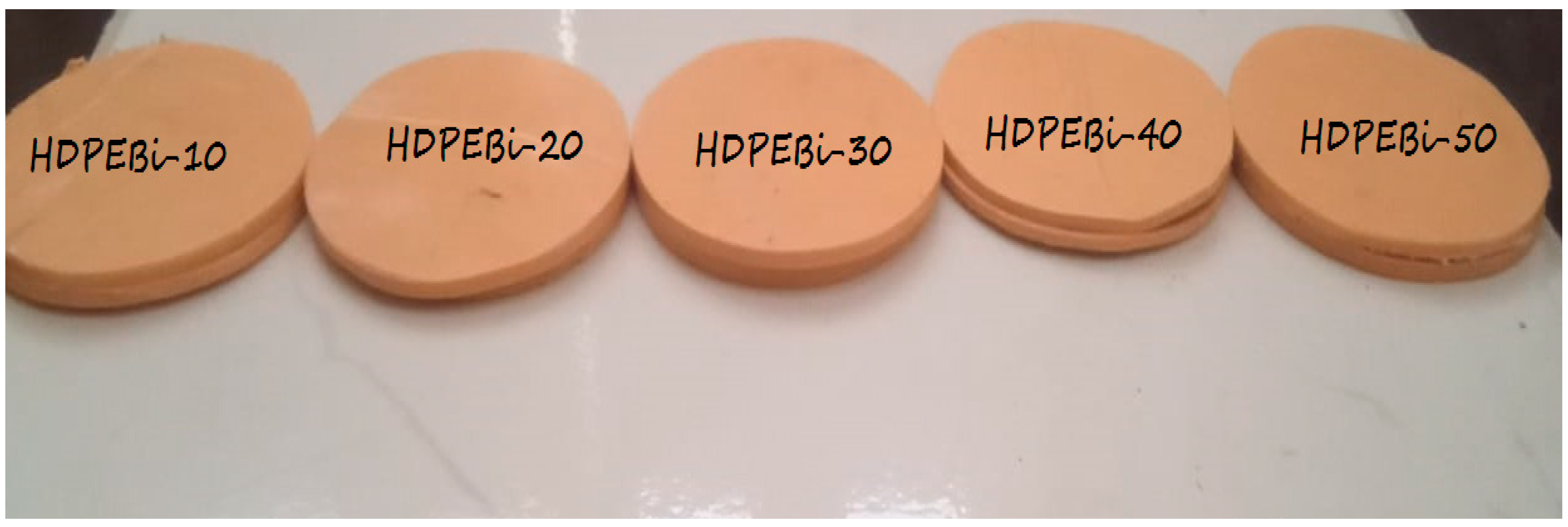



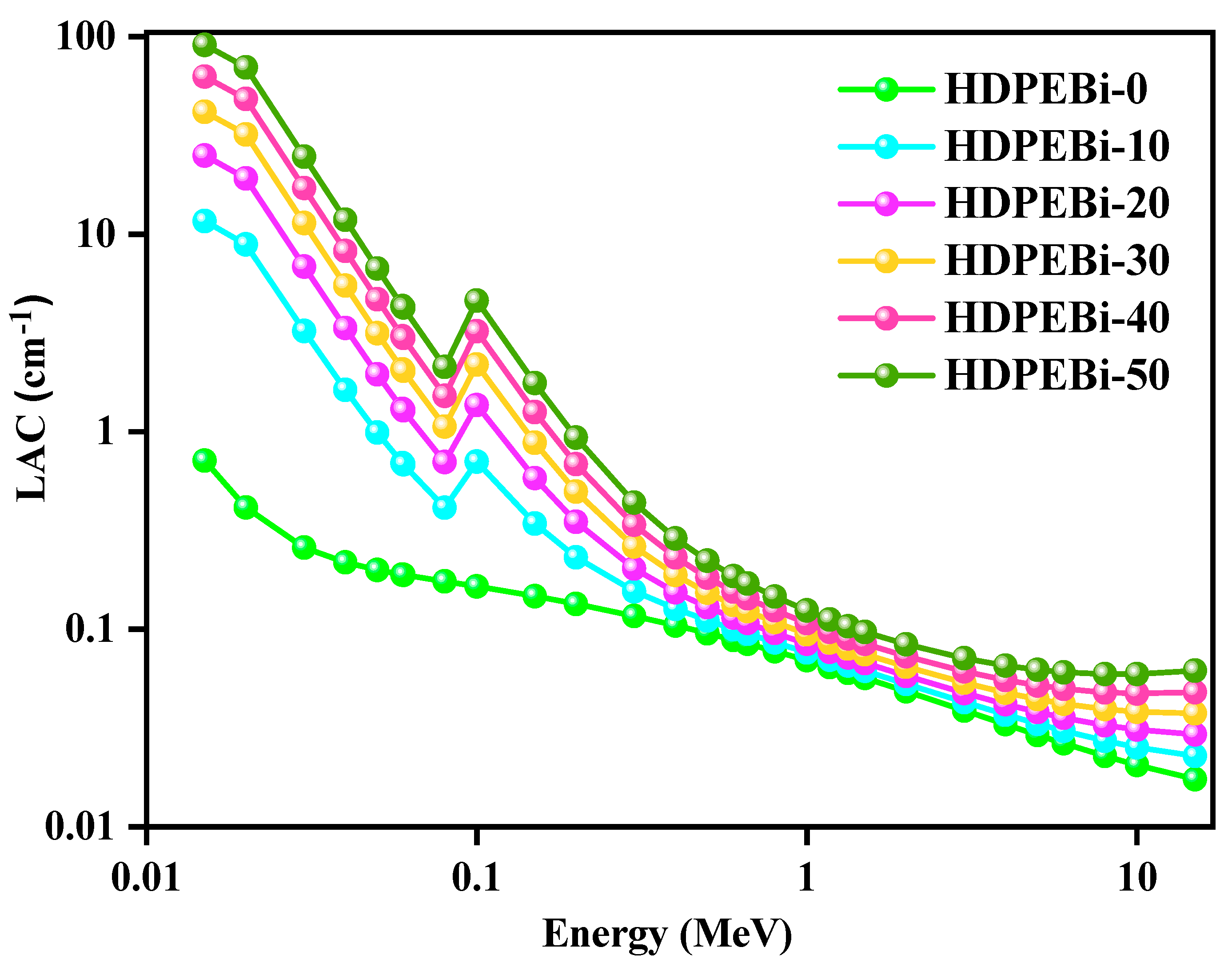
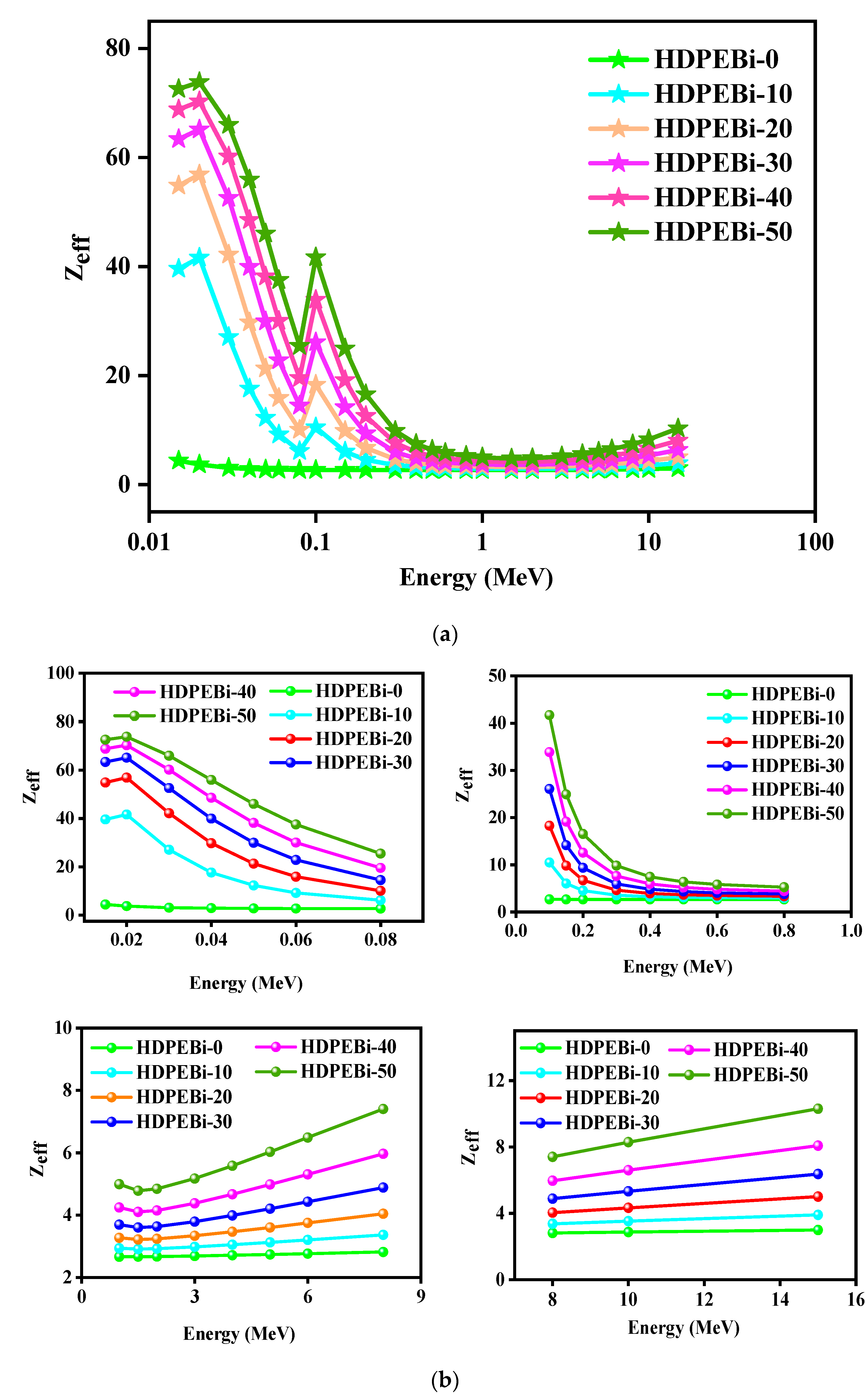
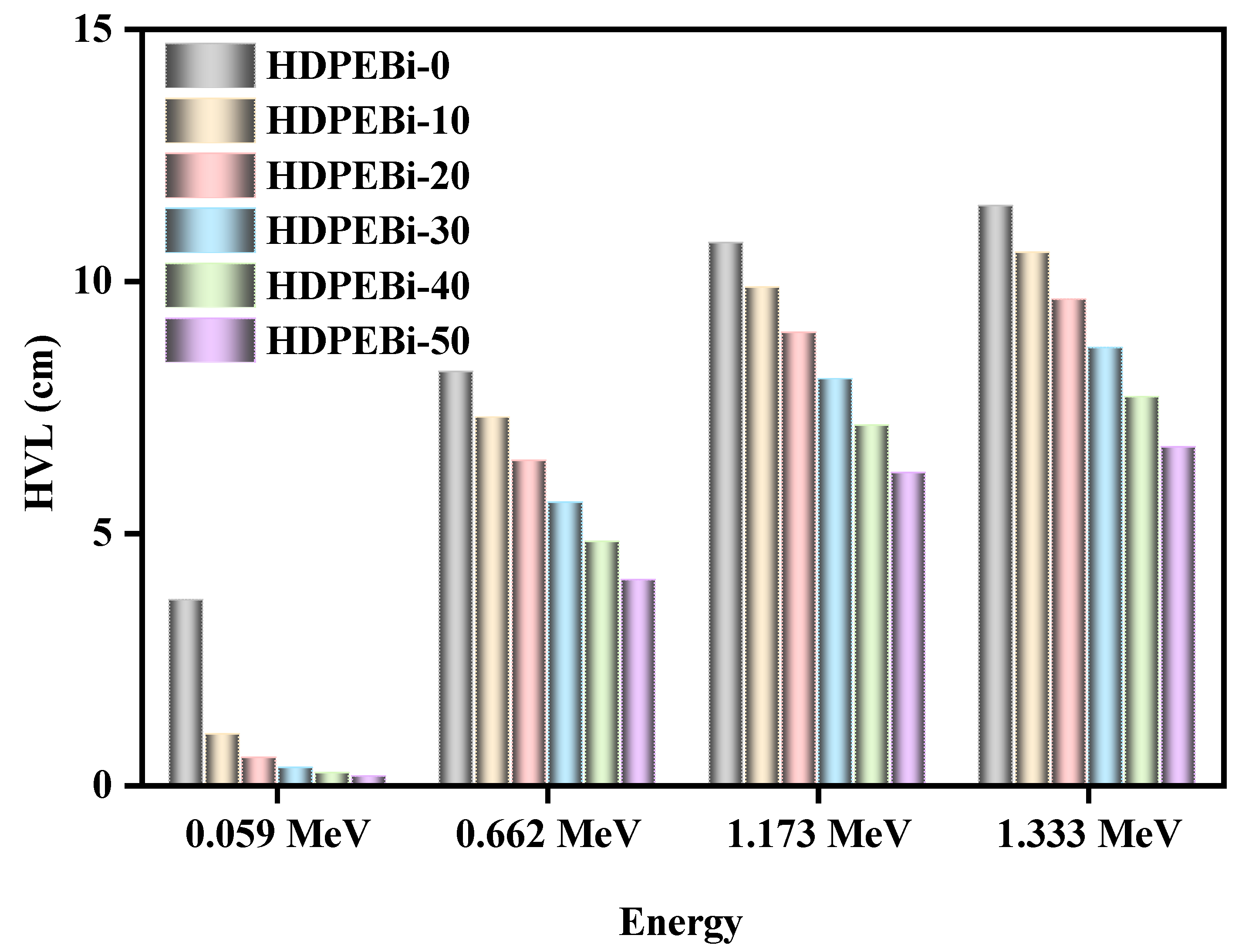
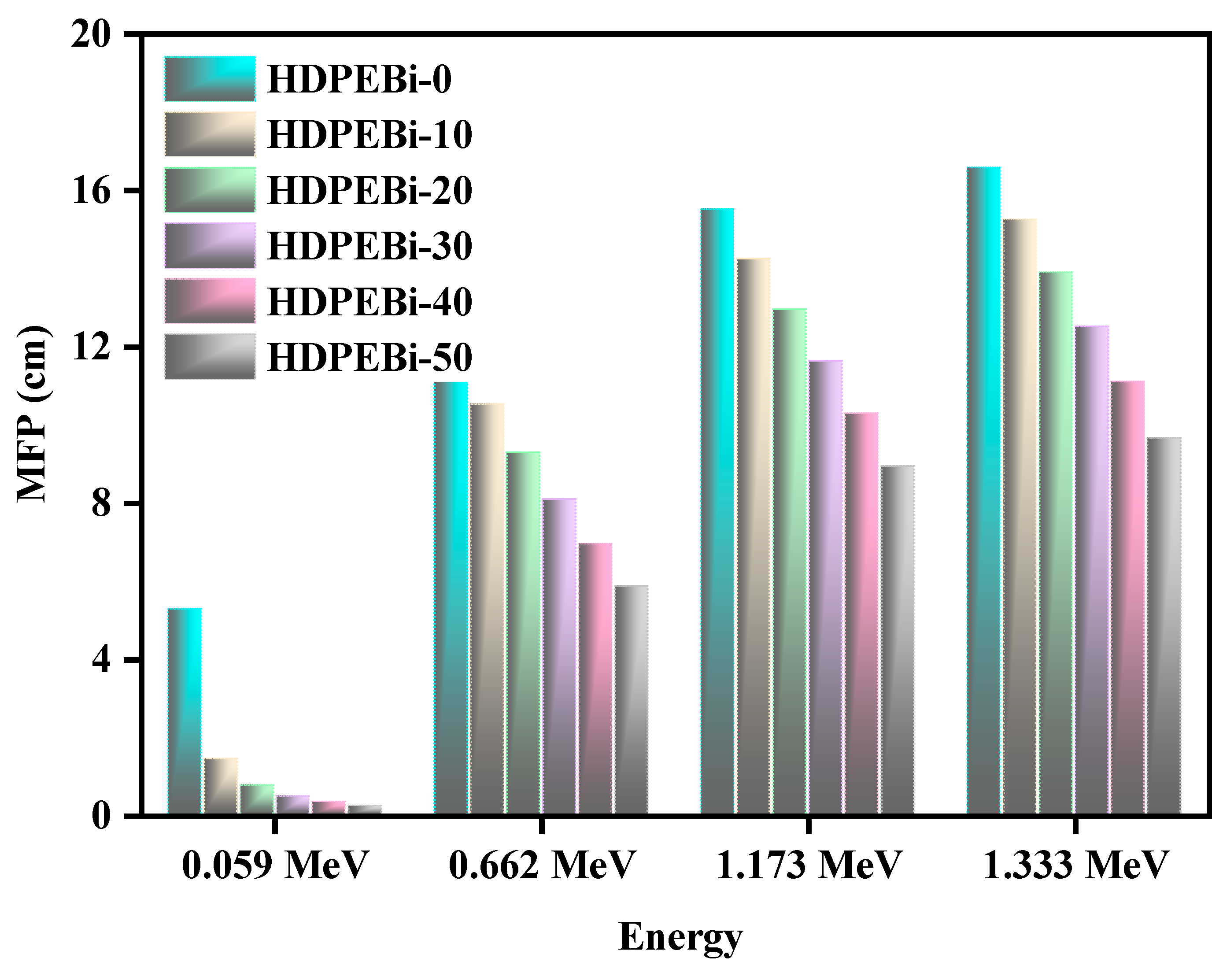
| Code | Composition (wt%) | Density (g/cm3) | |
|---|---|---|---|
| HDPE | Bi2O3 | ||
| HDPEBi-0 | 100 | - | 0.959 ± 0.005 |
| HDPEBi-10 | 90 | 10 | 1.053 ± 0.004 |
| HDPEBi-20 | 80 | 20 | 1.167 ± 0.009 |
| HDPEBi-30 | 70 | 30 | 1.310 ± 0.006 |
| HDPEBi-40 | 60 | 40 | 1.491 ± 0.003 |
| HDPEBi-50 | 50 | 50 | 1.731 ± 0.008 |
Publisher’s Note: MDPI stays neutral with regard to jurisdictional claims in published maps and institutional affiliations. |
© 2022 by the authors. Licensee MDPI, Basel, Switzerland. This article is an open access article distributed under the terms and conditions of the Creative Commons Attribution (CC BY) license (https://creativecommons.org/licenses/by/4.0/).
Share and Cite
Almuqrin, A.H.; Elsafi, M.; Yasmin, S.; Sayyed, M.I. Morphological and Gamma-Ray Attenuation Properties of High-Density Polyethylene Containing Bismuth Oxide. Materials 2022, 15, 6410. https://doi.org/10.3390/ma15186410
Almuqrin AH, Elsafi M, Yasmin S, Sayyed MI. Morphological and Gamma-Ray Attenuation Properties of High-Density Polyethylene Containing Bismuth Oxide. Materials. 2022; 15(18):6410. https://doi.org/10.3390/ma15186410
Chicago/Turabian StyleAlmuqrin, Aljawhara H., Mohamed Elsafi, Sabina Yasmin, and M. I. Sayyed. 2022. "Morphological and Gamma-Ray Attenuation Properties of High-Density Polyethylene Containing Bismuth Oxide" Materials 15, no. 18: 6410. https://doi.org/10.3390/ma15186410
APA StyleAlmuqrin, A. H., Elsafi, M., Yasmin, S., & Sayyed, M. I. (2022). Morphological and Gamma-Ray Attenuation Properties of High-Density Polyethylene Containing Bismuth Oxide. Materials, 15(18), 6410. https://doi.org/10.3390/ma15186410









